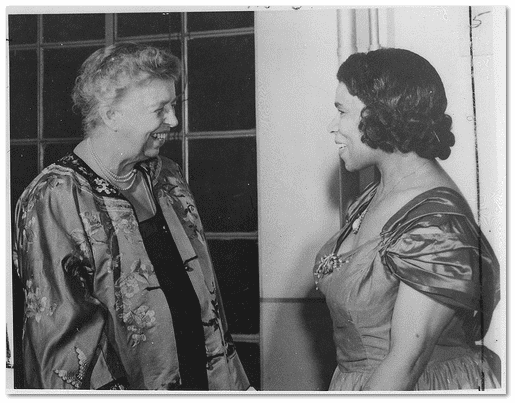Introduction: In this article, Gena Philibert-Ortega writes about Eleanor Roosevelt’s popular and long-running newspaper column, “My Day.” Gena is a genealogist and author of the book “From the Family Kitchen.”
When you think of Franklin Delano Roosevelt what comes to mind? Maybe it’s the fact that he was the only U.S. president to be elected to four terms. Maybe you’re familiar with the programs he helped to establish during the Depression, such as the Civilian Conservation Corps (CCC) and the Works Progress Administration (WPA). Maybe you remember the words from his speech after the attack on Pearl Harbor, calling it “a date which will live in infamy.” Our 32nd president led the nation during the difficult times of the Great Depression and World War II.
What do you know about his wife, Eleanor Roosevelt? She was a crusader for many political and social issues, including women’s and civil rights. Mrs. Roosevelt has a long list of accomplishments in her own right apart from being a first lady. Starting in late 1935 she became one of the most-documented first ladies in U.S. history, due to the fact that she began a syndicated newspaper column that she personally wrote. Eleanor worked on her column “My Day” six days a week, from 1935 to 1962, writing about her daily activities and giving her views on a range of subjects.
This 1935 newspaper notice announced the upcoming “My Day” newspaper column.

Many of Eleanor Roosevelt’s newspaper columns read like diary entries. In some cases, they resemble a letter to a dear friend—filled with her thoughts, conversations and opinions.
Her newspaper columns addressed many different topics; not all were especially poignant. For example, in one early column she discusses how much sleep she got and describes eating a tray of food by herself in her room. But looking at the totality of the columns helps paint a picture of the United States through the mid-20th century, reflecting the important issues our families faced such as war, poverty and racism. These “My Day” columns provide researchers with a social history of life during this time.
One issue that Eleanor Roosevelt was passionate about was civil rights. In her 21 February 1936 column, she mentions that she and her husband enjoyed a concert by African American singer Marian Anderson.

Three years later in February 1939 Eleanor Roosevelt quit the Daughters of the American Revolution (DAR) over their refusal to allow Marian Anderson to perform in Constitution Hall. At that time the Hall was segregated and the DAR refused to allow African Americans to perform there.
In her resignation letter, Mrs. Roosevelt stated:
“However, I am in complete disagreement with the attitude taken in refusing Constitution Hall to a great artist. You have set an example which seems to me unfortunate, and I feel obliged to send in to you my resignation. You had an opportunity to lead in an enlightened way and it seems to me that your organization has failed.”
You can view a copy of that DAR resignation letter on the National Archives website.
Thanks to the support of Eleanor Roosevelt and other like-minded individuals, Marian Anderson eventually sang at Constitution Hall at the invitation of the DAR in 1942.

Mrs. Roosevelt’s 27-year newspaper column spanned her time as first lady, when she became a widow, and when she worked with the United Nations. One of her only breaks from writing the columns was in the days following her husband’s death on 12 April 1945.
In her last column, which ran 26 September 1962, Eleanor was once again addressing the issue of civil rights. In that column she discussed the issue of desegregating the schools, saying:
“In the same way, we must realize that however slow the progress of school integration in the South, analogous situations exist over and over again in the Northern states. There the problem of school desegregation is closely tied to desegregation of housing; certainly we are not doing any kind of job that we could hold out as an example to our Southern neighbors.”
With that discussion Eleanor’s “My Day” column came to an end.* She died two months later on 7 November 1962 at the age of 78.
* “My Day” by Eleanor Roosevelt, 26 September 1962. Prepared by the Eleanor Roosevelt Papers Project.
